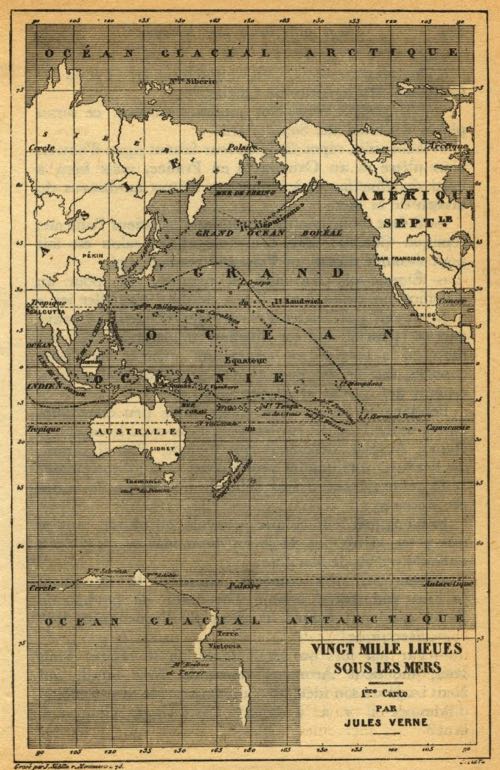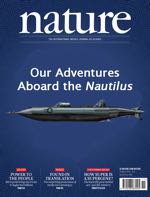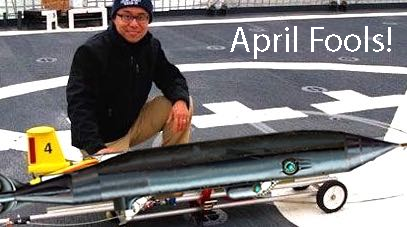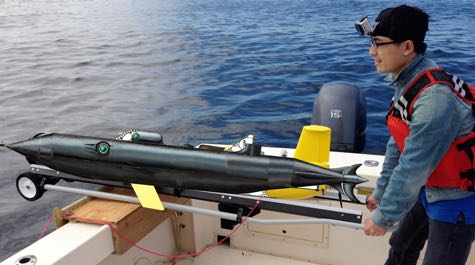Researchers circumnavigate ocean via ship and sub
Mid-voyage incident leads to startling discovery
Dr. Donglai Gong, an assistant professor at the Virginia Institute of Marine Science, returned today from a subsea circumnavigation of the globe that began last July aboard the USS Abraham Lincoln. Gong brought to the voyage his extensive experience in the use of autonomous underwater vehicles, or AUVs.
Gong was invited aboard the months-long international expedition in May of last year, shortly after a commercial vessel first sighted a large and unfamiliar marine organism in Australian waters. Subsequent sightings by vessels in the Pacific and Atlantic gained significant press coverage and gave impetus for the voyage.
Dr. Mark Luckenbach, who has been monitoring the situation in his role as Associate Dean of Research and Advisory Services at VIMS, says the creature was described as “spindle-shaped, occasionally phosphorescent, and infinitely larger and more rapid in its movements than a whale.”
Dr. Pierre Aronnax of the Paris Museum, who sailed with Gong as a lead investigator, says the sightings are further evidence of how little we know about the ocean. VIMS professor Deborah Steinberg, who wasn’t involved in the voyage but has logged thousands of miles on research cruises, agrees: “We know more about the surface of the Moon or Mars than we do about the depths of our own seas,” says Steinberg.
Commanding the Lincoln was Captain Jules Farragut. Also aboard were noted Canadian cetologist Ned Land, as well as VIMS grad student Daniel Wang, research specialist Jeanna Hudson, and adjunct professor Mike Vecchione, an international expert in giant squid.
Gong refrained from sharing the team’s final results, but did offer that the expedition “was filled with enough adventures to seem straight out of science fiction.”
The voyage—which ultimately traversed more than 20,000 leagues—was largely without incident until the crew had transited from the Atlantic to the Pacific via Cape Horn. “We first sighted the animal on November 5th near Japan,” says Gong. “At two cables' length from the ship, on the starboard quarter, the sea seemed to be illuminated with a very intense but mysterious light.”
Wang adds, “The luminous part traced on the sea an immense oval, much elongated, the center of which condensed a burning heat, whose overpowering brilliancy died out by successive gradations.”
The perils of marine research
Shortly after the initial sighting, the researchers deployed one of the Gong Lab’s Slocum Gliders to investigate. That’s when the expedition took an ugly turn, as the massive creature responded by loosing two enormous waterspouts and ramming the Lincoln.
 Jim Goins, Marine Safety Officer at VIMS, says it was the most treacherous incident he’s heard of during his long and storied career.
Jim Goins, Marine Safety Officer at VIMS, says it was the most treacherous incident he’s heard of during his long and storied career.
“Incident reports are usually a pretty dry read,” says Goins, “but this was as dramatic as a 19th-century novel.” He notes the waterspouts “broke over the bridge of the frigate, rushing like a torrent from stem to stern, overthrowing men, and breaking the lashings of the spars.”
Adds Gong, “A fearful shock followed, and, cast over the rail without having time to stop ourselves, we fell into the sea.”
It was while treading water in their emergency Mustang suits that Gong and his fellow shipwreck victims made their astounding discovery.
“After hours in the chilly waters, I wriggled myself quickly to the top of the object, half out of the water, which served us for a refuge,” says Gong. “I kicked it. It was a hard, impenetrable body, and not the soft substance that forms the bodies of the great marine mammalia.”
Vecchione initially thought the body “might be a bony covering, like that of the antediluvian animals.” But the group quickly realized their ‘floating island’ was smooth, polished, and without scales. In fact, it appeared to be made of riveted plates.
 “There was no doubt about it,” says Gong. “This monster that had puzzled the learned world and misled the imagination of seamen of both hemispheres, was a still more astonishing phenomenon, inasmuch as it was a simply human construction. We were lying upon the back of a sort of submarine boat, which appeared like a huge fish of steel.”
“There was no doubt about it,” says Gong. “This monster that had puzzled the learned world and misled the imagination of seamen of both hemispheres, was a still more astonishing phenomenon, inasmuch as it was a simply human construction. We were lying upon the back of a sort of submarine boat, which appeared like a huge fish of steel.”
In comments off the record, Vecchione hypothesized that the mysterious submersible was most likely patterned after a family of cephalopods, which includes a pelagic marine mollusk known as a Nautilus.
 Gong says the team will reveal the nature of their unprecedented discovery and subsequent underwater adventures in a Nature paper scheduled for publication later this week.
Gong says the team will reveal the nature of their unprecedented discovery and subsequent underwater adventures in a Nature paper scheduled for publication later this week.




